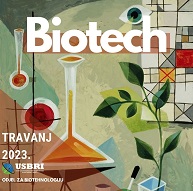Novosti iz biotehnologije
Spread of DNA databases sparks ethical concerns
In this Friday, March 2, 2012 file photo, DNA samples are processed at the New York State Police Forensic Investigation Center in Albany, N.Y. Countries around the world are collecting genetic material from millions of citizens in the name of fighting crime and terrorism. Few nations have been more enthusiastic than Britain, where a database of DNA from criminal suspects grew by 2012 to hold samples from almost 7 million people, more than 10 percent of the population. (AP Photo/Mike Groll, File)
You can ditch your computer and leave your cellphone at home, but you can’t escape your DNA. It belongs uniquely to you—and, increasingly, to the authorities.
Countries around the world are collecting genetic material from millions of citizens in the name of fighting crime and terrorism—and, according to critics, heading into uncharted ethical terrain.
Leaders include the United States—where the Supreme Court recently backed the collection of DNA swabs from suspects on arrest—and Britain, where police held samples of almost 7 million people, more than 10 percent of the population, until a court-ordered about-face saw the incineration of a chunk of the database.
The expanding trove of DNA in official hands has alarmed privacy campaigners, and some scientists. Recent leaks about U.S. surveillance programs by former NSA systems analyst Edward Snowden have made people realize their online information and electronic communications may not be as secure as they thought. Could the same be true of the information we hold within our genes? DNA samples that can help solve robberies and murders could also, in theory, be used to track down our relatives, scan us for susceptibility to disease, or monitor our movements.
Earlier this year Yaniv Erlich, who runs a lab at MIT’s Whitehead Institute for Biomedical Research, published a paper in the journal Science describing how he was able to identify individuals, and their families, from anonymous DNA data in a research project. All it took was a computer algorithm, a genetic genealogy website and searches of publicly available Internet records.
Read more at: Phys.org
Misuse of impact factors
More than 7000 scientists and 250 science organizations have by now put their names to a joint statement called the San Francisco Declaration on Research Assessment (DORA; am.ascb.org/dora). The declaration calls on the world’s scientific community to avoid misusing the Journal Impact Factor in evaluating research for funding, hiring, promotion, or institutional effectiveness. By publicly signing the Declaration the scientists officially declared that the Journal Impact Factor is being misused. Inappropriate use of the impact factor has infiltrated the scientific community to become an unwanted and pernicious mark of quality for science and scientists. It is pernicious in the sense that the simplistic use of metrics can give a skewed view of a researcher’s achievements. The problem is not restricted to individuals. Misuse of impact factors can also influence decisions on the fates of university departments and institutes as well as national decisions on the future of scientific programmes. Many scientists are worried about the way in which the impact factor is used in the assessment of research and this is one of the first occasions that there has been a broad call to action. The shared message for all audiences is that journal-based metrics, such as impact factors, should not be used as a surrogate measure of the quality of individual research articles, to assess an individual scientist’s contributions, or in hiring, promotion, or funding decisions.
DORA encourages publishers of scientific journals, to reduce the emphasis on the impact factor as a promotional tool either by ceasing to use it or by providing a balanced presentation of multiple metrics that provide a more differentiated view of journal performance. But we as scientists must also be aware that our own behaviors as authors, referees and members of evaluation panels and search committees have contributed to the role the impact factor plays now. The problem does not lie primarily with the impact factor itself. Metrics are not inherently bad but they become counterproductive when used incorrectly. The impact factor was developed to compare journals and to assist librarians in making decisions on subscriptions. There is nothing wrong with this, but it does not make sense to use the impact factor to compare the quality of research or researchers. If one wanted to rely on metrics at all to judge individual scientists, metrics that assess the performance of individual researchers and differentiate between the work of researchers in different areas of research would be more appropriate, such as the h-index or article-level, rather than journal-level, metrics, including citations; but these too need to be used critically, fairly and have limits. Another problem with using the impact factor to compare research is that it is a single metric for the whole range of the life sciences. Important distinctions between research fields have to be taken into consideration.
It would not be sensible to take the extreme position that journals do not matter. Ideally, a scientist should be evaluated on the content of his or her publications, not on the names or impact factors of the journals in which they publish. But when search committees or gpanels have to evaluate more than a hundred applicants to establish a short list for in-depth assessment, they cannot be expected to form their views by reading the original publications of all of the applicants. I believe that the quality of the journal in which research is published can, in principle, be used for assessment because it reflects how the expert community who is most competent to judge it views the science. There has always been a prestige factor associated with the publication of papers in certain journals even before the impact factor existed. This prestige is in many cases deserved. Publication in the best journals matters not because of the association with the impact factor, but because of the high standards of the journals, their staff and the value that comes from the peer review process. It is generally accepted that a consistent publication record in quality journals – however quality may be judged or measured – does reflect excellence in research.When the impact factor is misused everyone suffers: the scientist who has to try to publish in high impact journals that may not even exist in his or her field, the journal that is prestigious but has an impact factor that is insufficient to attract articles from scientists who are increasingly under pressure to collect credit points in the form of high impact factors, and the institutions and university departments which may find it difficult to achieve or retain diversity and breadth of scientific scope. We, the scientists, both as authors and as evaluators, should stop being obsessed with the impact factor, but we should not throw out the baby with the bath water and assume that the quality of journals is irrelevant.
Targeting DNA: After 20 years of high-profile failure, gene therapy is finally well on its way to clinical approval
The concept is simple: if a mutated gene is causing a problem, replace or supplement it with a new, accurate copy. In theory, such a strategy could not just treat, but cure countless human genetic diseases. In practice, however, developing safe and effective gene therapies has not been easy. Even when identifying a disorder’s genetic basis is fairly straightforward, finding the appropriate delivery vector to target the diseased tissues in the body, while avoiding unintended consequences, has challenged would-be gene therapists for more than 20 years. But more and more researchers are convinced that the technique is on the brink of becoming a common medical practice.
European Agency Recommends Gene Therapy Approval
European regulators have recommended approval of the Western world's first gene therapy drug - after rejecting it on three previous occasions - in a significant advance for the novel medical technology. More than 20 years since the first experiments with the ground-breaking method for fixing faulty genes, scientists and drug companies are still struggling to apply gene therapy in practice. Friday's decision by the European Medicines Agency (EMA) is a win for the drug's maker, the small Dutch biotech company uniQure, and a potential lifeline for patients with the ultra rare genetic disorder lipoprotein lipase deficiency (LPLD).
Effects of Herpes Simplex Virus Vector–Mediated Enkephalin Gene Therapy on Bladder Overactivity and Nociception
The effects of herpes simplex virus (HSV) vector–mediated enkephalin on bladder overactivity and pain have been previously reported. In this study, autors evaluated the effects of vHPPE (E1G6-ENK), a newly engineered replication-deficient HSV vector encoding human preproenkephalin (hPPE). vHPPE or control vector was injected into the bladder wall of female rats 2 weeks prior to the following studies. A reverse-transcription PCR study showed high hPPE transgene levels in L6 dorsal root ganglia innervating the bladder in the vHPPE group. The number of freezing behaviors, which is a nociceptive reaction associated with bladder pain, was also significantly lower in the vHPPE group compared with the control group. The number of L6 spinal cord c-fos–positive cells and the urinary interleukin (IL)-1β and IL-6 levels after resiniferatoxin (RTx) administration into the bladder of the vHPPE group were significantly lower compared with those of the control vector–injected group. In continuous cystometry, the vHPPE group showed a smaller reduction in intercontraction interval after RTx administration into the bladder. This antinociceptive effect was antagonized by naloxone hydrochloride. Thus, the HSV vector vHPPE encoding hPPE demonstrated physiological improvement in visceral pain induced by bladder irritation. Gene therapy may represent a potentially useful treatment modality for bladder hypersensitive disorders such as bladder pain syndrome/interstitial cystitis.
Kontakt
Radmile Matejčić 2
51000 Rijeka
Tel. +385 51 584 550
ured@biotech.uniri.hr
OIB: 64218323816
IBAN: HR3724020061400006958
Radmile Matejčić 2, O-047
http://studentska.uniri.hr/
Nadležna studentska liječnica:
dr. sc. Marijana Turčić, dr. med. spec. školske medicine
Radmile Matejčić 5, Rijeka
051/584 875 / 876
e-mail:
skolska.kampus@zzjzpgz.hr













.png)




